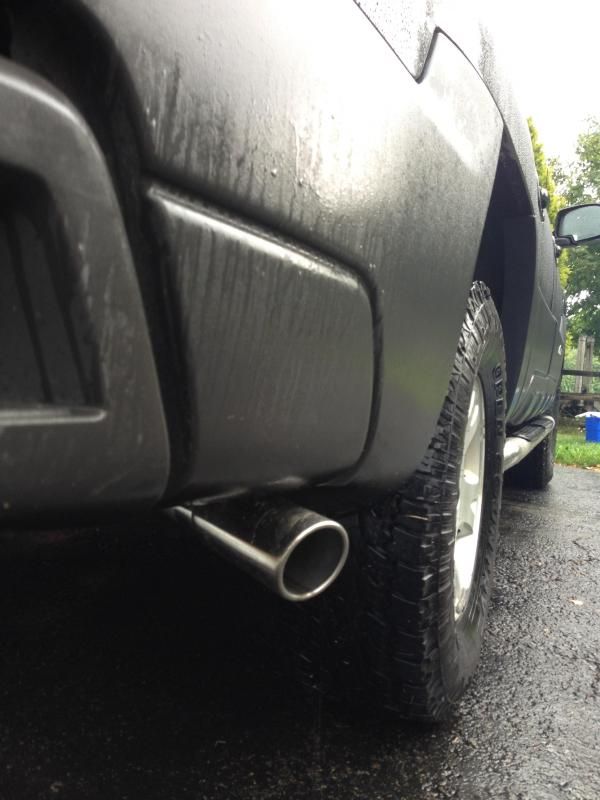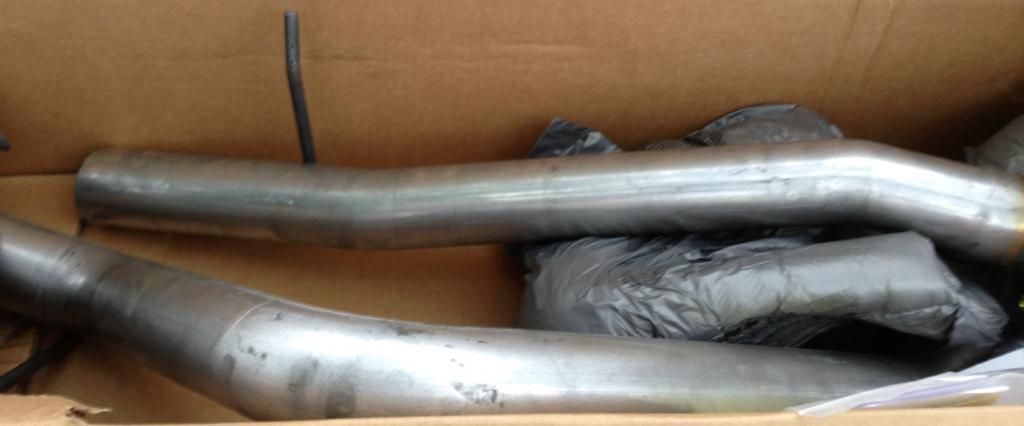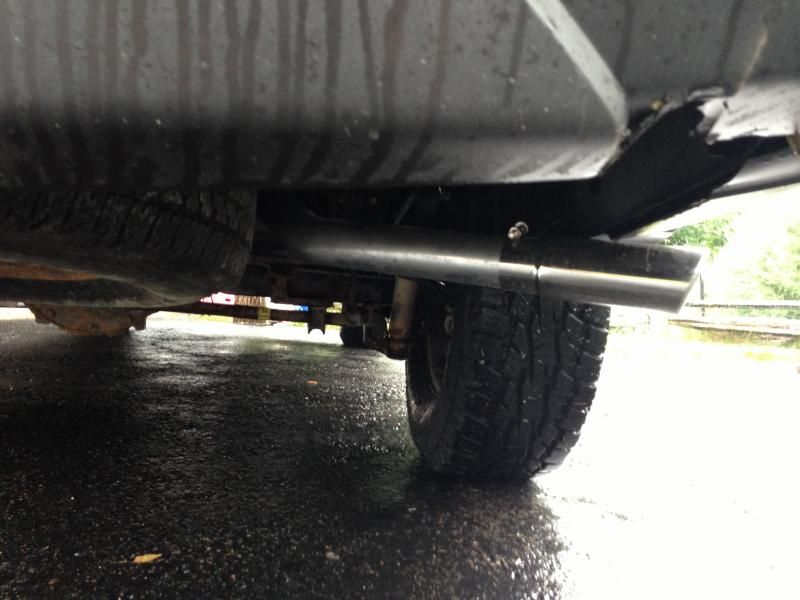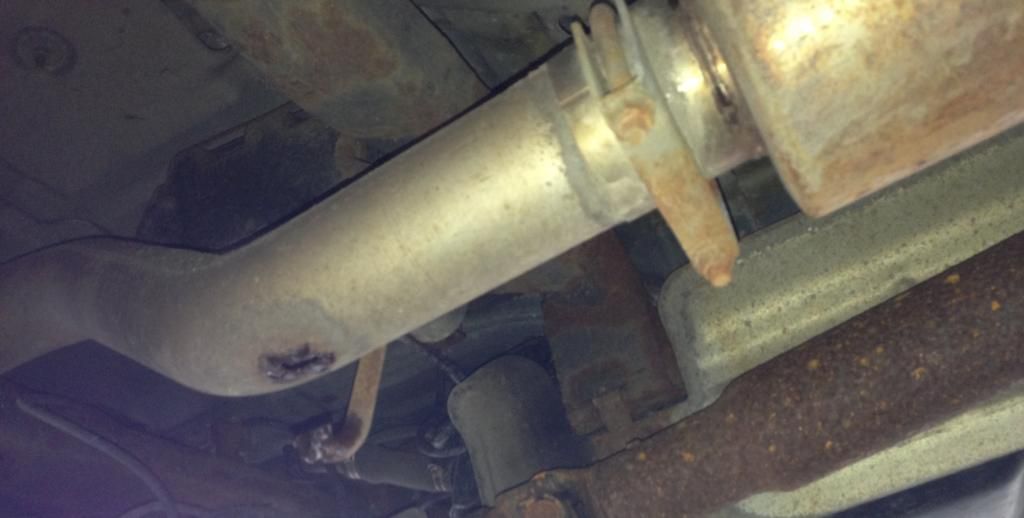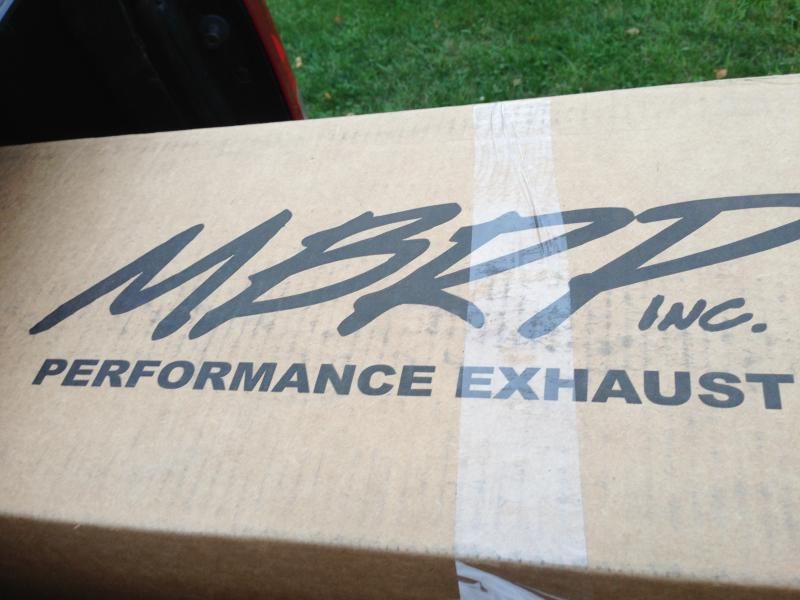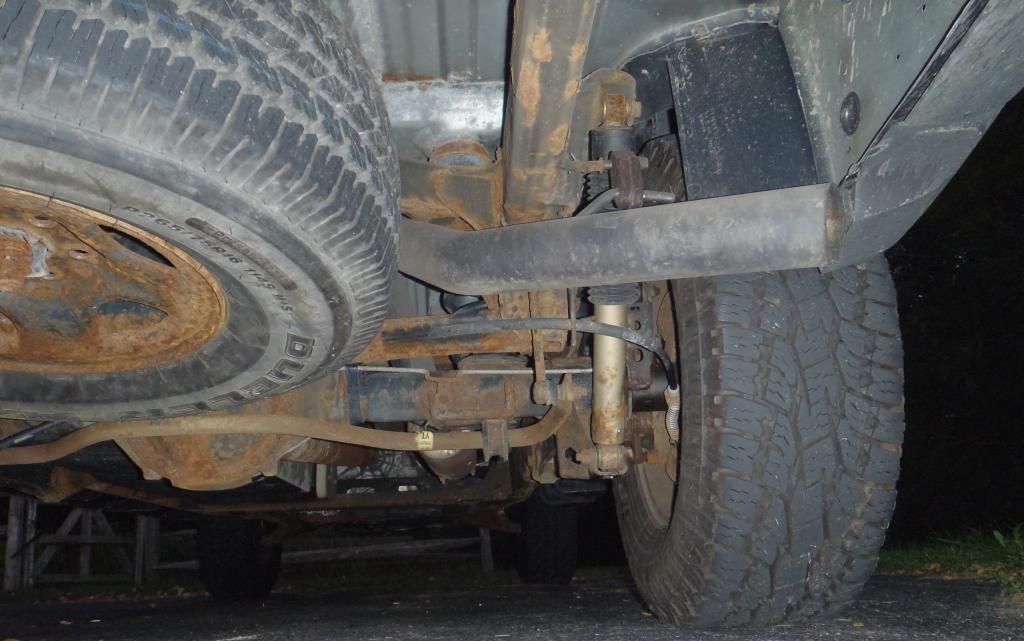Tire
Comparison: Goodyear Wrangler DuraTrac vs. Toyo Open Country ATII (AT2)
 |
| Goodyear Wrangler DuraTrac |
 |
| Toyo Open Country ATII (AT2) |
In short, both of these tires will help you keep your 4WD bragging rights and off-road ability, but neither will make you feel like you were irresponsible in buying an all-out mudder for your rig that has to be able to handle street duty. The following compare/contrast is here for those of us unsure as I was as to which type tire best fits their wants/needs.
APPEARANCE
No 4x4 should be wearing shoes that look like those commonly run on a minivan, end of story. The number of compliments and questions I got while running the DuraTracs became borderline absurd. People asked, “what are they?,” “how do they do in the mud/snow?,” “where can I buy them?,” and on and on and on. They simply look like nothing else out there and give off an air of aggression that even some mud tires can’t match. The tread pattern seems to mimic that of the bottom of a Timberland boot (a real Timberland)...all good stuff here for the Goodyear, and the pictures speak for themselves.
 While
the ATII’s sidewall isn't overly menacing, the tread has enough
meat and depth to it so that you won't mistake it for something
stock. This doesn't look
like a tire you want to attack the Rubicon Trail with, but you
probably wouldn't hesitate to run it through some mud, decently
deep snow, or do some mild wheeling with it. Think “street tire with lugs that are open enough to
clean out fairly well.” It’s tame and understated, but not weak. Still,
it can't match the absurdity that is the Goodyears' design.
While
the ATII’s sidewall isn't overly menacing, the tread has enough
meat and depth to it so that you won't mistake it for something
stock. This doesn't look
like a tire you want to attack the Rubicon Trail with, but you
probably wouldn't hesitate to run it through some mud, decently
deep snow, or do some mild wheeling with it. Think “street tire with lugs that are open enough to
clean out fairly well.” It’s tame and understated, but not weak. Still,
it can't match the absurdity that is the Goodyears' design.
Advantage:
DuraTracs - no question here
AROUND
TOWN
It's easy for a tire with an aggressive tread to wobble at low speeds, especially when accelerating and decelerating between a stop and 10 MPH. Luckily, the spacing and pattern of the DuraTrac minimizes this...when compared to something geared even more towards off-highway use. The lugs are positioned close enough together so that the voids don't cause a shake or wobble, and since it doesn't have a totally horizontal layout (ex. Super Swampers), vibration truly is minimal. The Pro Comp A/T’s I had years ago were worse.
Even with its Load E rating, the
Toyo is undoubtedly smoother around town, sometimes eerily so. Additionally, the tires help to
eliminate some of the smaller disruptions in pavement that you would
otherwise feel in your lower back. Very refreshing after 25K miles
with the DuraTrac.
Advantage:
Toyo
HIGHWAY
CRUISING
Be it the regular commute or towing the quad trailer, a good tire has to inspire confidence in you when you're moving at speed. It really does help to know you won’t suddenly wander out of the lane, and it’s also nice to feel that in a panic-stop situation the tires under your vehicle will work to your advantage.
With
low mileage on the set, the DuraTracs were surprisingly pleasant and
had good characteristics overall at higher speeds: wander wasn't
bad and braking distances were “good enough.” They did,
however, squirm a fair share under hard braking, which only got worse
over time. Overall, highway quality was decent but dropped
off quickly after 20,000 miles, the point at which they became
drastically worse riding and exhibited some characteristics –
wander, bad braking distances, excessive noise – that were enough
to force me into buying a new set (they were replaced by the Toyos).
On
the contrary, the Toyos performed admirably on the highway. Wander
was even less than the DuraTracs, braking distances were great for a
tire of this genre, and they were smooth riding and coasted with
ease. Honestly, these tires portrayed the best driving
characteristics of any tire I've ever owned, aggressive or not.
Advantage:
Toyos
NOISE
Noise
is commonly a big issue when dealing with truck tires in plus-sizes. Highway
hum can be overly aggravating if you're not accustomed to the noise
of the M/T's, and it can truly make you enjoy the time spent in your vehicle less than you otherwise would.
The
compound Goodyear uses for its DuraTrac is much
softer than that used by Toyo in the ATII, and such is one factor why
it makes a lot more noise. Furthermore, the open, criss-crossing
tread of the DuraTrac does itself no favors here. Chalk it up to the
Goodyear being geared more towards traction in off-road
situations, prioritizing grip and ability over pleasantness. Still,
it could be worse; the DuraTracs are noticeably quieter than the
typical mudder.
As quiet as the Goodyear is for a tire of this style, the Toyo is drastically quieter, silent to extent that you almost forget they're rotating continuously
beneath you. To call the DuraTrac bad in the noise department is a
totally relative statement, because Goodyear has made a valiant effort in helping the DuraTrac to be easy enough to drive around on without them
humming your ears off. Meanwhile though, the ATII is outstanding
when it comes to road noise. Again, different styles, different
purposes; these only become more obvious as you spend more and more time with each.
Advantage:
Toyo
HANDLING
Yes, this does matter when it comes to trucks;, seeing as nobody wants their
vehicle to feel sloppy going around a corner even if said vehicle
weighs upwards of three tons. The DuraTracs, with their soft makeup,
did well on mountain roads and really gripped the pavement when pushed hard.
Likewise, the Toyos did mighty fine for a tire not designed to be
driven like you would a sports car, but that didn't stop me from
doing so when the Avalanche was my only vehicle. The one big
difference between these two was that the Toyos were much more
progressive in their limits whereas the Goodyears would hang on and
then give up suddenly with little to zero notice. Either way, unless
you're on a race track, both tires do very well, better than one
would even expect. The nod goes to the Toyo though, for having less
sidewall roll in the corners and for being more forgiving in their
ways when driven hard.
Advantage:
Toyo
BRAKING
Be
it in slow-speed traffic, at cruising speed, or especially with a trailer
hitched to the back, braking performance is crucial
when it comes to truck tires, if not the most important aspect.
Here the Toyos reigns supreme, with absolutely zero drama to them and
dead-straight, worry-free stopping qualities. The DuraTracs, while
largely problem-free, do squirm a little under hard braking which is only worsened when there's a trailer behind the
truck. It's nothing that would be considered “worrying” and
they really are competent enough to handle any kind of towing duty you can do with your light-duty vehicle,
but if you know you have to slam the brakes often it's something to
consider. Both are good, but the Toyo continues to shine when it
comes to on-road personality.
Advantage:
Toyo
RAIN, SNOW, AND ICE – HARSH DRIVING CONDITIONS
Presumably you also drive not only in good weather, but in the bad as well: rain, snow, ice, and the like. You don't want your truck to let you down, and you expect the same from your tires.
Rain should be fairly straight-forward: hydro-planing is bad, end of story. Luckily, neither of these tires showed even the faintest sign of inability to cope with water on the roadways, be it constant rain or post-downpour standing water. And both tires will, when given the cattle prod, handle wet-condition drifting with ease (a friend told me this). I'd probably choose the DuraTrac though, for it stays a little more sure-footed when coming across puddles in the road.

 Snow is probably my favorite condition to drive in, but while stepping the back out in the winter is hysterical childish fun, you want to feel safe when you're not fooling around. Let's start with how the tires perform in a dusting: in 2WD the DuraTrac does well, though it gets a little tail-happy when you're hard on the gas and the snow is light. The Toyo is similar but to a lesser extent. In 4WD the tires handle light snow flawlessly (really as if it isn’t even there). Medium-depth snowfall is similar, with the DuraTrac pulling a slight lead as the Toyo's lesser ability to clean out becomes evident. In deep snow, however, the tires' differences suddenly become major: the DuraTrac will go places in 2WD where the Toyo requires the extra two front wheels spinning. There's pretty much no snowstorm that the Goodyears can't handle once you engage 4WD, and it's reassuring to know you can still get wherever you need/want to go when the winter weather suddenly turns bad. I live at the top of a massive hill and there were situations in which the Toyos required the handy 4WD switch when I could still make it in 2WD with the Goodyears and some modulated wheelspin. Summary: the DuraTracs definitely portray the better snow-going abilities and were a more competent drifting companion as well.
Snow is probably my favorite condition to drive in, but while stepping the back out in the winter is hysterical childish fun, you want to feel safe when you're not fooling around. Let's start with how the tires perform in a dusting: in 2WD the DuraTrac does well, though it gets a little tail-happy when you're hard on the gas and the snow is light. The Toyo is similar but to a lesser extent. In 4WD the tires handle light snow flawlessly (really as if it isn’t even there). Medium-depth snowfall is similar, with the DuraTrac pulling a slight lead as the Toyo's lesser ability to clean out becomes evident. In deep snow, however, the tires' differences suddenly become major: the DuraTrac will go places in 2WD where the Toyo requires the extra two front wheels spinning. There's pretty much no snowstorm that the Goodyears can't handle once you engage 4WD, and it's reassuring to know you can still get wherever you need/want to go when the winter weather suddenly turns bad. I live at the top of a massive hill and there were situations in which the Toyos required the handy 4WD switch when I could still make it in 2WD with the Goodyears and some modulated wheelspin. Summary: the DuraTracs definitely portray the better snow-going abilities and were a more competent drifting companion as well.
Advantage: DuraTrac
OFF-PAVEMENT
 |
| Pardon the poser pic... |
You don't have to be an expert in tires to know how this is going to go. Just by glancing at the two tires side-by-side it's almost laughably easy to tell that the DuraTrac will perform better off-road. A more intricate pattern, more openly spaced lugs, more aggressive sidewalls, and a softer compound all help contribute to the DuraTrac's benefits versus the Toyo's closer lug spacing and harder-composition. Put simply, this is a matter of being deliberately designed for more off-road use, and it shows. Here's a *quick* breakdown of off-road characteristics:
Mud: Toyo has obvious disadvantage with more road-friendly tread; DuraTrac does well and cleans out as one would expect.
Rocks: DuraTrac likes to throw rocks hard and far but otherwise climbs like a mountain goat. Soft sidewalls are concerning, though. Toyo does well on rock-only surfaces but doesn't like climbing as much due to harder makeup; also picks up many smaller rocks in tread-blocks and holds them there.
 Fire roads: DuraTrac holds straight and reacts well to inputs, whether small or large. Toyo rides more harshly and is twitchy at speed. Drift-ability is a wash; the DuraTracs drift better at higher speeds and the Toyos are more cooperative in low-speed sideways action.
Fire roads: DuraTrac holds straight and reacts well to inputs, whether small or large. Toyo rides more harshly and is twitchy at speed. Drift-ability is a wash; the DuraTracs drift better at higher speeds and the Toyos are more cooperative in low-speed sideways action.
Advantage: DuraTrac
TREADWEAR
Tires
don't last forever. Just like the cars or trucks they ride under,
every model has a lifetime and, accordingly, that varies based on
many factors. Composition, hard/soft, tread pattern, and others (especially driving style) have
an effect on how long a particular set will last, and the two sets in
this comparison are no exception.
 At
20,000 miles or so, the Goodyears took a quick turn for the worst; by
around 25K, they were showing heavy signs of wear: low tread,
increased noise levels, and worsened braking/handling
characteristics. 25K would be decent for a mud tire but it's a
little disappointing here, where I expected 30-35K. And though I must admit my driving habits were no help to longevity,
25K equates to basically a year's worth of driving for me. That's not a lot
of life out of a set.
At
20,000 miles or so, the Goodyears took a quick turn for the worst; by
around 25K, they were showing heavy signs of wear: low tread,
increased noise levels, and worsened braking/handling
characteristics. 25K would be decent for a mud tire but it's a
little disappointing here, where I expected 30-35K. And though I must admit my driving habits were no help to longevity,
25K equates to basically a year's worth of driving for me. That's not a lot
of life out of a set.
On
the contrary, the Toyos seem to have endless life in them. As of
this writing there’s ~20K miles on the set and they look just as
they did when they were brand new. My dad has the same tires (down
to the size and load rating) on his 2500HD Silverado – a much
heavier truck – and his set was just
starting to show wear at around 50K miles, and that's with a fair
share of towing and hauling. At this rate he will get 60-65K out of
them before he buys another set, and I wouldn’t be surprised if the
set on the Avalanche lasts even longer. This is shockingly good, and acts as a financial benefit as well.
Advantage:
Toyo
PRICE/VALUE
Truck
tires are, in a phrase, painfully expensive. $1000 for a set is
totally commonplace for plus-sized kits, and your wallet will suffer
accordingly. In identical sizes, Goodyear charges a fair amount more per tire – about $30-50 depending on the source – than does Toyo.
It would be fair to argue that those who prioritize off-road
performance are willing to pay more for their rubbers to minimize the hit in on-road performance and, for how well it performs, the
DuraTrac is priced competitively versus other tires that
only do slightly better when the pavement ends (yet struggle to hold
themselves together at all when hitting the highway). For the price,
the DuraTrac is a great value.
As
for the ATII, Toyo has managed to create an incredibly long-lasting,
quiet, pleasant, all-weather-capable tire that looks the part and is
up to the off-road task 75% of the time. At $30-50 less per tire
than the Goodyears and with a lifetime of about 25K longer per tire, Toyo scores extremely
high in the value factor. It's a great tire that
will last long past the point at which you're thinking about your
next set, and performs well along the way.
Advantage:
Even (both pose great values in their own right)
CONCLUSION
After
spending years with both of these tires under the same truck, it's
easy to hone in on where one betters the other and which is best
in each discipline. It's impossible to belittle the Goodyear
DuraTrac's off-road capabilities, but ignoring the Toyo ATII's on-road
dominance wouldn't be fair either.
It comes down to this: if
you drive your truck daily and really don't off-road it that much,
stick to the Toyo Open Country ATII (AT2); its longevity and road manners are simply
outstanding, it doesn't flop on its face when the going gets tough, and it'll never fail you in its duty. However, the
Goodyear Wrangler DuraTrac is a great option for the guy that wants
the off-road look (or abilities) without the tradeoffs that typically come along with a
dedicated off-road tire. It manages to handle regular on-pavement
driving just fine, and adds a menacing look to any vehicle.
 What
we can conclude from this comparison is that the age of off-road
tires having horrid downsides is well past us. Modern light-duty
truck tires are in fact capable of multiple responsibilities and
can in fact look good doing so. Additionally, this comparison has proven how different two tires that show up under the
same grouping on a website can actually be. Both of these tires
prove that retaining road manners is not mutually exclusive from
performing well in winter weather conditions or when wheeling your
rig, and also that it is possible to justify a somewhat more
aggressive tire even if it's not what suits your driving best. Hats
off to Toyo and Goodyear for two great creations.
What
we can conclude from this comparison is that the age of off-road
tires having horrid downsides is well past us. Modern light-duty
truck tires are in fact capable of multiple responsibilities and
can in fact look good doing so. Additionally, this comparison has proven how different two tires that show up under the
same grouping on a website can actually be. Both of these tires
prove that retaining road manners is not mutually exclusive from
performing well in winter weather conditions or when wheeling your
rig, and also that it is possible to justify a somewhat more
aggressive tire even if it's not what suits your driving best. Hats
off to Toyo and Goodyear for two great creations.
Oh,
which would I buy? Probably the DuraTrac, even though the Toyo
undoubtedly suits my needs better. I just can't get over how great
the Goodyears look; in writing this article I realized I had taken easily 100 times as many pictures of the truck with the Goodyears than the Toyos, and with how minimal the trade-offs are, I would willingly suffer through a little extra road noise and shorter treadlife to love how the truck looks.
-Ross, 10/29/14
Edit: 11/12/14 - for proper/improper use of term "directional"
Edit: 11/12/14 - for proper/improper use of term "directional"












